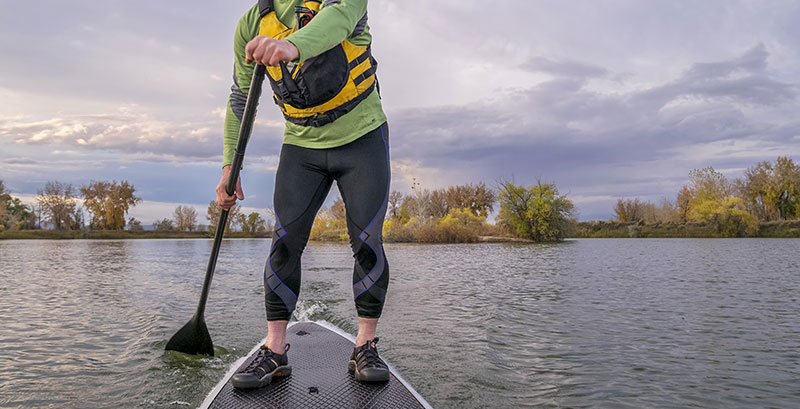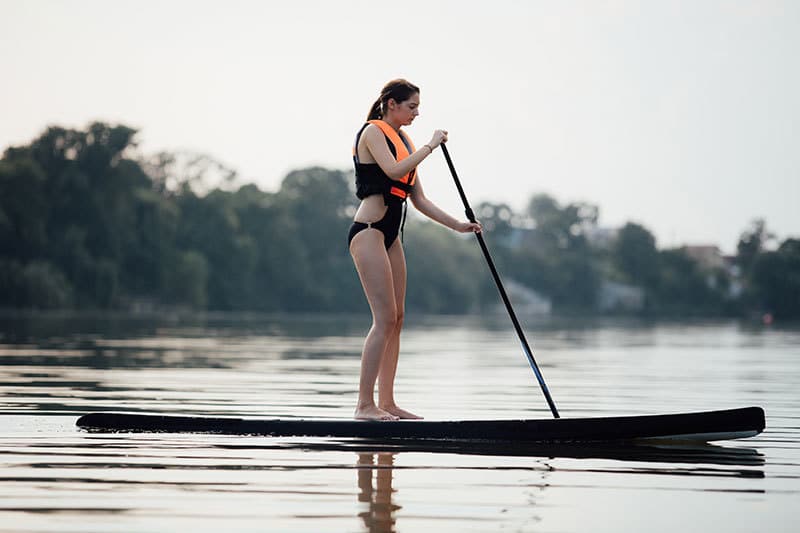If you’re looking for a new way to enjoy the water, the outdoors, or to get a full body core workout, try stand up paddle boarding (SUP boarding), the fastest growing water sport worldwide.
Although its US popularity began to grow after surfer Laird Hamilton began using it as a workout in 2004, it’s actually thousands of years old.
Historically, Ancient African, Hawaiian and Peruvian cultures surfed their waters using a paddle and a board.
It provides a sport opportunity for people of all ages and skill levels.
Most people find it easy to learn and start paddling the waters in minutes.
Stand Up Paddle Boarding Equipment
You can buy or rent a board and other equipment. Many waterside vacation spots offer rentals.
You’ll need four items to get started:

Stand Up Paddle Board
Like surf boards, paddle boards come in various shapes and sizes, but paddle boards are thicker than surfboards – about 4 to 5 inches.
They’re commonly constructed of epoxy and fiberglass surrounding an EPS foam core. A SUP features one or more fins that help it track in the water.
Boards range in length from 8 to 12 feet and 28 to 32 inches in width.
When you first start SUP boarding, choose a longer, wider, thicker board for the best stability in a beginner paddle board.
One of the top brands for beginners that we suggest is Isle Surf and SUP. And, you can choose from inflatable stand up paddle boards and hard (rigid) stand up paddle boards.
One thing to keep in mind that is even heavier, overweight people can enjoy this sport as long as they buy a proper SUP to support their weight.
Paddle
You’ll find an even greater variety of paddles. A plethora of handle, shaft and blade shapes exist.
You could choose a paddle constructed of plastic, wood, aluminum or carbon fiber.
The important thing is to choose a paddle that’s 6 to 10 inches longer than your height.
Leash
If you’ve surfed or watched someone surf, you’ll recognize the leash that attaches to your board and to your ankle via a Velcro strap.
The leash provides a vital safety measure that keeps you with your board in the event you fall.
Choose a leash the same length or slightly shorter than your board.
Personal Floatation Device
The US Coast Guard considers SUP boards a vessel, so if you navigate past the swim or surf area, you must wear a USCG-approved life jacket/vest.

Kneeling and Standing on a Paddle Board
Start in calm, flat water, suggests REI. Carry the board into the water, setting it down when the water is deep enough that the fin won’t hit the bottom, but still shallow.
To get on the board:
- Stand beside the board.
- Lay the paddle across the board’s deck with the paddle’s grip on the board’s edge and the blade on the water.
- Grasp the board by the edges and the paddle grip with one hand.
- Climb on the board just behind its center in a kneeling position.
While kneeling, learn the balance of the board. In your perfect balance point, the nose (front of the board) doesn’t pop up and the tail (rear of the board) doesn’t dig into the water.
Keep your hands on either side of the SUP board while you stabilize it.
To stand:
- Place one foot on the board at a time.
- Place your foot where your knee was.
- Repeat the process.
- Keep your feet parallel to one another about shoulder width apart.

Paddling The Proper Way
Your eyes and your arms have to work together. Look in front of you while paddling.
Practice your grip before you get out on the water so you don’t need to look at your hands.
You must remain aware of debris or obstructions in the water.
To paddle:
- Grip the paddle with one hand on its top and the other at the shaft’s center. The blade angle should face away from you.
- Hold the paddle in front of you.
- Bend your elbows at a 90 degree angle.
- Keep your bottom arm, the one at the shaft’s center, as still as possible.
- Pull your top arm toward your body.
- Insert your paddle into the water as far forward as possible.
- Pull yourself past your paddle.
To navigate in a straight line, make two or three strokes on one side, then switch sides making the same number of strokes.
When you change sides, you’ll also switch your hands’ positions on the paddle. If you’ve paddled a canoe or kayak before, the concept is similar.
To turn left, paddle on the right side while simultaneously turning your torso to the left. Keep a low stance.
You’ll feel the board’s shift.
To turn right, paddle near the tail (rear), pulling toward the nose (front) while turning your torso to the right.
Using a low stance with bent knees makes the board turn more easily.
With a little practice, you’ll be exploring your favorite lake or inlet and getting a great workout.
SUP boarding provides a fun way for families to workout together or explore their favorite body of water.
